Rediscovering Route 66
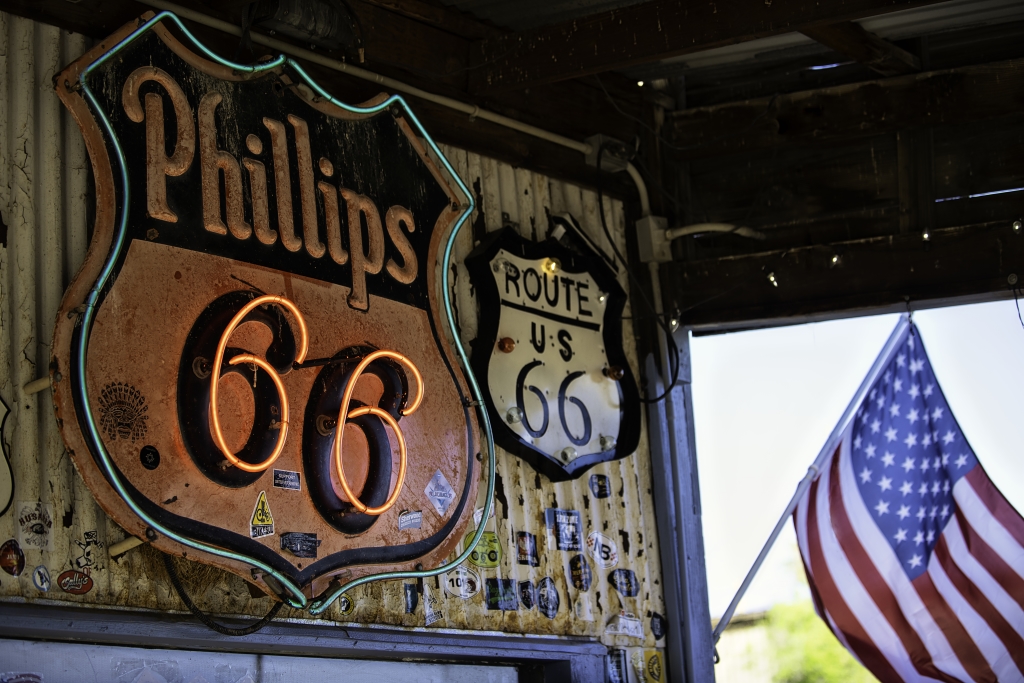
Arizona’s Nostalgic Highway
Writer Joseph J. Airdo and Rebecca L. Rhoades // Photography by Dave Pisani
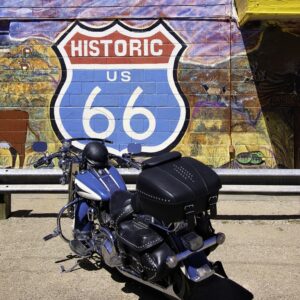


Nearly a century after its establishment, Historic Route 66 remains America’s most legendary highway — a ribbon of asphalt cutting across the Southwest that promises adventure, nostalgia and a different pace of life rarely found in our modern world.
“Historic Route 66 is just a different experience than a lot of other vacations,” says Nikki Seegers, director of operations of the Historic Route 66 Association of Arizona. “People are seeking out the nostalgia of a different time in history and also a different pace of life that we no longer see.”
U.S. Route 66 was established Nov. 11, 1926, with road signs erected the following year. Originally spanning 2,448 miles from Chicago to Santa Monica, California, it forever changed how Americans traveled. The path across Arizona essentially followed a 35th parallel trade route that had been established as a wagon road in 1857, later utilized by the railroad.
Oklahoma businessman Cyrus Avery, known as “The Father of Route 66,” helped lay out the system of numbered highways, dubbing this one “Main Street of America.” The name itself — Route 66 — was chosen partly because roads ending in multiples of 10 were transcontinental and partly because Avery thought the number was phonetically pleasing.
Prior to the highway, towns like Seligman and Kingman were isolated, with only designated railroad stops claiming much attention from travelers. Route 66 changed everything.
“After World War II, everyone took to the road, wanting to take their families out and see America,” Seegers explains. “Roadside attractions, cafes and motels started popping up to cater to these new traveling Americans. It really fueled their creativity as to how to get people to stop.”
John Steinbeck immortalized Route 66 in his 1939 novel “The Grapes of Wrath,” bestowing upon it the enduring sobriquet “The Mother Road.” By 1946, it entered popular lexicon through Bobby Troup’s song “(Get Your Kicks on) Route 66,” sung by Nat King Cole.
Those who lived and did business along U.S. Route 66 became prosperous thanks to the highway’s popularity. So when President Dwight D. Eisenhower introduced the Federal Aid Highway Act in 1956, creating the interstate system that would bypass small towns along Route 66, communities were devastated.
Williams became the last town bypassed by I-40 in 1984, and U.S. Route 66 was officially decommissioned the following year. All signs were removed and the highway disappeared from maps.
“There is this famous photo of Angel Delgadillo and his brother Juan who, on the day U.S. Route 66 was decommissioned, put folding lawn chairs in the middle of the road and just sat there with not a car passing by,” Seegers says. “Everybody wanted to use the new road, so these small towns and mom-and-pop businesses died.”
Delgadillo — owner of a barbershop and pool hall in Seligman — refused to accept this fate.
“Angel really wanted to come up with a way to get people back into these small towns, so they would not have to relocate to larger cities,” Seegers says. “So he started talking about creating a group that could help promote Route 66 as a historic highway.”
On Feb. 18, 1987, Delgadillo called a meeting at Seligman’s Copper Cart restaurant. Fifteen people attended and formed the Historic Route 66 Association of Arizona. The group lobbied until the state christened the portion from Seligman to Kingman as Historic Route 66. Other states followed Arizona’s lead.
Today, the Mother Road is experiencing a renaissance. Its stretch across Arizona features eight distinctive communities, each offering its own charm and character. From west to east, travelers encounter the frontier atmosphere of Oatman, the historical richness of Kingman, the photogenic Hackberry General Store, colorful Seligman, Grand Canyon-adjacent Williams, cosmopolitan Flagstaff, Eagles-famous Winslow and prehistoric Holbrook.
Many travelers have specific destinations in mind, while others find joy in simply driving the highway and seeing where it leads. The Historic Route 66 Association of Arizona enhances the experience with a passport program, allowing travelers to collect stamps at stops along the highway and earn a certificate stating they “got their kicks on Route 66.”
Travel writer Roger Naylor, who wrote “Arizona Kicks on Route 66” and hosts a podcast devoted to Route 66 road trips, believes the highway’s enduring appeal lies in its representation of American values.
“Roll your window down and crank the radio up,” Naylor advises. “Enjoy the road trip for the sake of the road trip. That is the Route 66 experience. Discover the little joys that you find along the way; those moments of scenery and those connections you make with people. It is a way of life that you are afraid may have vanished. But it has not. Bygone days are not gone at all. They just exist along Route 66.”
Whether seeking adventure, history, quirky attractions or simply a different pace of life, Historic Route 66 delivers an iconic American experience that continues to capture the imagination of travelers from around the world. This summer, consider exploring the Arizona stretch of the Mother Road — where the journey itself is truly the destination.
Oatman: Where the Wild West Lives
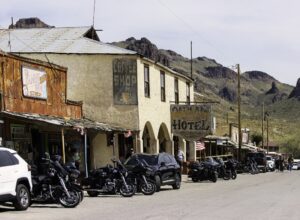


The most frontier-themed of Arizona’s Route 66 destinations, this former gold-mining town high in the Black Mountains welcomes visitors with old-timey buildings, souvenir shops and plank sidewalks. Getting here requires navigating narrow roads with sharp hairpin curves, but the journey rewards the adventurous.
Wild West gunfights are staged in the town center on weekends, but the main attraction is the wild burros — descendants of pack animals brought by miners in the late 1800s — that roam freely through town. More numerous than human residents, these friendly creatures greet tourists each morning, happily accepting alfalfa pellets sold in local shops.
For an authentic taste of the Old West along Route 66, few experiences match Oatman’s unique character and living history.
Kingman: The Heart of Historic Route 66



Proclaiming itself “the heart of Historic Route 66,” Kingman offers one of the most comprehensive histories of the storied highway at its Route 66 Museum. After photographing yourself under the giant drive-thru Route 66 shield, explore Locomotive Park’s 1928 locomotive or visit the Kingman Railroad Museum in the historic train depot.
About 25 minutes east at the former Kozy Corner Trailer Court stands one of the route’s most unusual attractions: Giganticus Headicus, a bright green 14-foot-tall tiki-/Easter Island-style head created by artist Gregg Arnold. The property also showcases several vintage cars, old gas pumps and more of Arnold’s eccentric artworks.
Complete your visit at Mr. D’z Route 66 Diner, instantly recognizable by its turquoise-and-pink facade and vintage automobiles. Inside, midcentury touches abound, including a checkered floor and Elvis and Marilyn decor. Don’t miss their homemade root beer or one of their two-dozen milkshake flavors.
Hackberry: A Photographer’s Dream
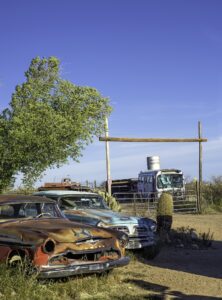


Midway between Kingman and Seligman, this tiny village is known for one spectacular attraction: the Hackberry General Store. Nicknamed the “mother lode of Mother Road memorabilia,” this photogenic time capsule draws Route 66 enthusiasts from around the world.
The property features a treasure trove of vintage cars, antique gas pumps, hundreds of classic signs, neon lights and weathered cow skulls. Inside, the space functions as both a museum and souvenir shop, complete with a midcentury diner setup.
No matter how many times you visit, there’s always something new to discover among the carefully curated chaos. For photographers and nostalgia seekers alike, Hackberry General Store represents the quintessential Route 66 experience — unpolished, authentic and utterly captivating.
Seligman: The Birthplace of Historic Route 66
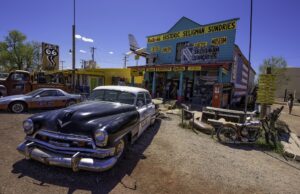


This tiny town packs more color and character into a quarter-mile than seems possible. Historic businesses, eye-popping signage, junk shops and oddball emporiums line the main drag, alongside classic automobiles in various stages of decay. Seligman Sundries displays cars decorated to resemble characters from Disney-Pixar’s “Cars,” which drew inspiration from Arizona’s Route 66 locations.
The Rusty Bolt gift shop features mannequins standing guard on its roof. Don’t miss Angel Delgadillo’s world-famous gift and barber shop, where the man who spearheaded Route 66’s revival worked until his retirement.
For a taste of pure roadside Americana, visit the colorful Delgadillo’s Snow Cap Drive-In, built in 1953 by Angel’s brother Juan. This kitschy landmark serves classic diner fare amid vintage cars and memorabilia, embodying the spirit that saved Route 66 from obscurity.
Williams: Gateway to the Grand Canyon
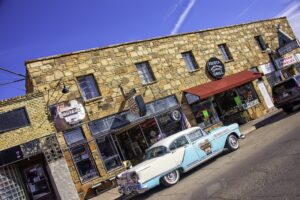


Nestled in Kaibab National Forest, Williams serves as the starting point for the Grand Canyon Railway, which carries more than 200,000 visitors annually to the canyon’s South Rim. The town’s main street, a National Historic District, features vintage gas station museums, historic train cars, renovated motels and a replica Old West village.
Animal lovers can explore Bearizona, home to bears, wolves, wild cats and other North American wildlife through drive- and walk-through tours. Thrill-seekers will enjoy Canyon Coaster Adventure Park, which opened in 2022, offering a mile-long mountain coaster reaching speeds of 27 mph.
The Grand Canyon Railway Hotel provides one of Route 66’s most luxurious accommodations with nearly 300 rooms and an indoor pool. Before departing, sample Pine Country Restaurant’s hearty American cuisine and save room for its legendary homemade pies.
Flagstaff: Mountain Town Sophistication



As the largest community along Arizona’s Route 66 and home to Northern Arizona University, Flagstaff offers a cosmopolitan experience at 7,000 feet elevation. The world’s first International Dark Sky Community, this mountain town balances historic charm with modern amenities. Though you won’t find collections of neon and rusty cars, numerous historic buildings and colorful Route 66 murals line the streets.
Flagstaff boasts a flourishing culinary and craft beer scene — sample local brews at Mother Road Brewing Co. or dine at one of the city’s James Beard Award-nominated establishments. The Americana Motor Lodge and High Country Motor Lodge offer stylish accommodations with retro flair for nostalgia-seekers.
Before heading east, consider detours to Twin Arrows and Two Guns — once-thriving stops now reduced to picturesque ruins — or Meteor Crater, the massive impact site of a meteorite that struck approximately 50,000 years ago.
Winslow: Standin’ on the Corner
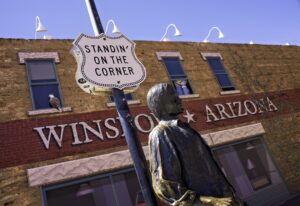


Even those who have never visited know Winslow from the Eagles’ 1972 hit “Take It Easy.” The lyrics “I’m a-standin’ on a corner in Winslow, Arizona” put this former railroad stop on the map, and the city capitalized by creating Standin’ on a Corner Park. This popular photo opportunity features a mural depicting a flatbed truck and eagle, a bronze statue resembling songwriter Jackson Browne, and a massive Route 66 marker.
Just outside town, Homolovi State Park preserves hundreds of petroglyphs and ruins of ancient Anasazi and Hopi pueblos. For an extraordinary overnight experience, book a room at La Posada, designed by legendary architect Mary Colter.
This hacienda-style masterpiece, restored after nearly facing demolition, sits on 12 acres of lush gardens. The hotel’s Turquoise Room offers a distinguished dining experience featuring regional Southwestern and Native American cuisine amid saltillo tile flooring, stained glass and custom chandeliers.
Holbrook: Prehistoric Wonders
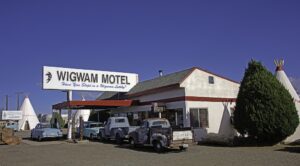


Once known as “the town too tough for women and churches,” Holbrook now serves as the perfect base for exploring Petrified Forest National Park — the only national park bisected by Route 66. This 350-square-mile wonderland features vividly colored formations, petroglyphs, massive fossilized trees and diverse wildlife.
In town, “rock shops” abound, identifiable by their dinosaur statues. Jim Gray’s Petrified Wood Co. and the Rainbow Rock Shop draw photographers with their herds of concrete dinosaurs, while the Painted Desert Indian Center also features impressive prehistoric replicas.
For the ultimate Route 66 experience, spend a night at the Wigwam Village Motel No. 6, one of only three remaining wigwam villages in the country. These concrete tepees — each containing twin beds and a small bathroom — represent the quirky roadside architecture that made Route 66 famous, offering modern travelers a genuine connection to the highway’s golden age.

